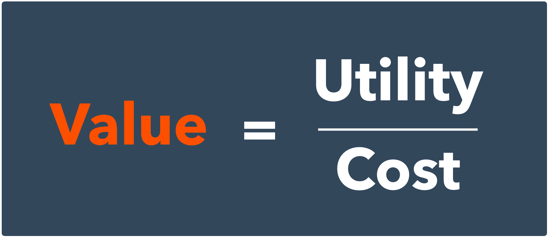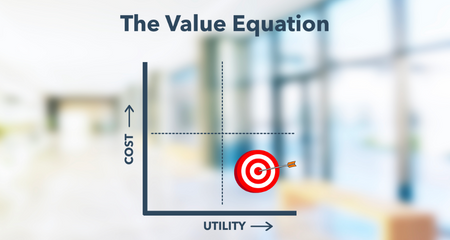“Everything is worth what its purchaser will pay for it.”
Publilius Syrus, first century BCE
If you’ve ever gone grocery shopping while you were hungry, you can understand how universal and powerful the concept of value is. When we shop hungry, we tend to load the cart with foods that satisfy our immediate hunger, rather than more nutritious options that require more preparation.
Why? Because in the moment, hunger overrides our other values – including our health consciousness.
Our sense of value drives our buying behavior in everyday life, and it drives how CRAs and background screening companies choose to allocate resources and purchase people-data. Yet, the definition of value can be elusive. You’re more likely to hear someone say, “I know value when I see it,” rather than define value as a quality of a product or service.
Nevertheless, there is a specific universal formula that our brains seek to optimize as we search for valuable products and services:

Sounds simple, right? The value we receive from a product or service equals its utility divided by its cost. If cost and utility move together, value remains constant. If utility increases and cost remains the same, value increases.
This is what you experience when you receive a “free” update providing a new set of features for a piece of software that you already own. You perceive that you are getting more without paying more, so you experience greater value.
Conversely, in today’s gasoline market, cost is increasing without any new utility being added. (It’s not like more expensive gas will get you any farther.) Our perception of value decreases. This tends to make us grumpy and ultimately can lead to reduced consumption.
Appreciating this formula and making good choices about resources based on their value requires that a CRA has a solid grasp of the component parts: utility and cost. Not only does the value equation impact your selection of data and technology providers, how profitable, nimble and scalable your business is, but your clients buy from you because of your value proposition—your CRAs utility divided by the cost of your service - the way you integrate with their ATS’, how embedded your processes into theirs or vice-versa, the method you use to adjudicate their results for example. If they didn’t, wouldn’t your customers simply buy from the cheapest background screening company? And we all know the agony decisions made on that basis lead to. Misconceptions about cost and utility are common, based on assumptions inspired by popular culture and advertising. So it’s critical that we understand value both the value our partners offer and the value we offer our customers.
What is utility in the value equation?
Utility is the perception of or actual use that we receive from a product or service.
Some utilities are perceived as universal. For instance, to most people, the utility of gasoline is to power a motor vehicle. That’s it.
However, utility can also be subjective. Other products and services may represent different utilities to different consumers. For some, an automobile is simply a means to get from point A to point B. A person who embraces this utility optimizes value by selecting the least costly vehicle that is safe, economical, and reliable.
For others, the utility of the automobile represents an extension of personal characteristics. Someone who sees the utility of an automobile this way might opt to purchase a bright red Porsche 911 cabriolet, not because it transports them better than a Honda Civic, but because the utility of the Porsche represents something that the Honda will never offer.
How do CRAs view utility?
Savvy CRAs always consider the utility of the background screening data they purchase. The utility of people-data is often measured in terms of these five characteristics:
- How reliable is the data
- How quickly background check requests are returned
- Whether the results are provided consistently and in actionable form
- Whether the data integrates with other information in a larger process
- Whether the method of providing the background check results are private and secure.
Data that is direct-source people-data seeks to optimize each of these 5 qualities using people, process and technology so that CRAs using direct-source people-data recognize the greatest utility.
What is cost in the value equation?
Our perceptions of utility can also change over time and circumstance. The utility of a bottle of water may be much greater if you’re on a hike across the desert than if you’re at home in your kitchen. Similarly, cost can be much more difficult to pin down than it might initially appear.
Cost, like utility can be measured in many ways. Cost can be objective, as in, “the cost of a gallon of gas is $3.57.” For most people who purchase that gallon of gas, that is where the definition of cost ends. However, for someone who links gasoline to carbon emissions that may harmfully warm the planet, the cost of that gallon is immeasurably more than $3.57.
How do CRAs view cost?
When considering the cost of people-data, cost might be measured in terms of opportunity.
For example, when a CRA selects a data provider for criminal records and court data, a check of the county in which a prospect resides might cost $1.50. A check for another prospect in another county that provides automated data access might cost $0.65. The information in the search results is the same but the cost varies dramatically. As such a CRA might opt to outsource the lower value manual searches and perform high-value automated searches with internal resources. But as many CRAs discover, maintaining staff to handle uncertain volumes of even high-value searches can have an opportunity cost because building and maintaining a team to service unpredictable volume may lower value (idle staff) and make it more difficult to pivot to address market changes. One option a CRA has for reducing average search cost, and the cost of maintaining staff, is finding a people-data partner that offers flat pricing regardless of whether searches are automated or manual. More on that in a moment…
Using the value equation when considering third-party background screening data providers
Now, think about buying people-data – criminal records research, for example. The same simple value equation applies. (value equals utility divided by cost.)
If our five factors for people-data utility are the same across all providers, then the market for people-data is completely commoditized. In other words, the only factor influencing the value a CRA receives, is price. If this was the case, CRAs would shop for data by finding the cheapest price possible and any time a provider’s data cost less, the CRA would switch. After all, the court record is the same for an individual, regardless of who pulls it.
But we know that people-data utility isn’t the same across all providers. Factors like turnaround time, security, county coverage, and process integration all contribute to the utility a CRA receives and vary by provider depending on the investments a provider makes in its own people, process and technology. The best relationships between CRAs and people-data providers – those that offer the greatest utility - exist when a CRA’s utility expectations align with a provider’s investments in people, process and technology and ongoing vision for enhancing the value of people-data.
Similarly, cost is never as simple as picking a number off a price list. Often people-data provider’s price lists have thousands of lines of excruciating detail whereas a CRA’s contract with an end user may have very simple pricing required to secure the deal. Connecting the dots between line items isn’t easy. Add to that, that a CRA may have both internal team costs and outsourced costs. The cost factor in our value equation suddenly becomes both complex and can be end user dependent for each contract a CRA has.
It can be helpful to step back from this risk and complexity and take a completely different look at cost. The best-case scenario exists when the cost a CRA is charged is consistently some percentage less than what the CRA charges an end user. The mark up is profit. Fortunately, people-data providers using direct source data have the ability to model their costs accurately and by working together with a CRA, can offer flat pricing that matches the way CRAs sell search results. CRAs realize the best relationships with people-data providers when costs and cost models align with the way CRAs sell search results to end users.
Summary
The value equation is a tool our brains use each time we make buying decisions even when we’re unaware it’s influencing our behavior. Both utility and cost can be complex to quantify and require CRAs to evaluate their own expectations, business goals and organizational structure. Often utility and cost, as they pertain to people-data, defy the numbers on a price sheet or presumptions about insourcing and outsourcing. By understanding the factors that influence perceived utility and cost and selecting data providers based on business alignment in people, process and technology, CRAs can make more informed choices about people-data providers and build data partner relationships that enable greater competitiveness, scaling to meet market dynamics and happier end users.
Ready to talk value? Contact us today.

